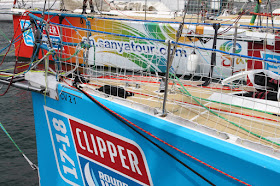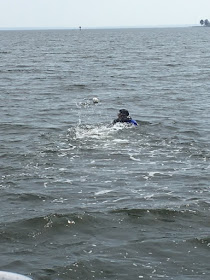Safety Gear
Seven years ago I posted
this rant about the notion that you could buy safety and some of the ridiculous things new sailors are persuaded to believe they need. Safety comes from understanding your situation and knowing your limitations. However, there is equipment that comes in handy from time to time.
86. PFDs. In fact, I don't wear these very much. For the most part, I rely on a harness and tethers. I do wear a PFD when whitewater kayaking and occasionally in the dinghy when condition suggest it. But mostly I try to stay out of the water.
I have an aversion to automatic inflating PFD's. As a singlehander, I may need to climb back on board, and doing anything to help yourself in an inflated PFD is comically awkward. I also don't understand the likelihood of falling overboard unconscious and surviving that. The boat is not going to stop and no one is going to help me back aboard. Thus, as a singlehanded sailor I find that absurdly unlikely.
In fact, it is simple to
convert automatic PFD's to manual. In the case of the Spinlock Pro series, it is a $20 conversion kit.
87. Harnesses. The key factors are fit and band width. The strap must fall on the sternum; lower and you can't breath, higher and it will try to choke you. It must be warn snugly enough so that you feel it when you inhale--otherwise, it can slide over your shoulders. What about crotch straps? In fact, I have a new design that will be in Practical Sailor in a few months. Instead of a ball-crusher, it is fully fall-rated (I took numerous vertical falls up to 6 feet in testing).
The other key factor is the width of the band. 45 mm is the standard minimum, but wider, up to 4 inches is proportionally better. Try hanging from the harness before you buy and you will understand. According to the UIAA and OSHA, hanging from a chest harness for more than 30 seconds can cause permanent injury to the nerves in the arm pits.
88. Tethers. Big article this month in PS. It seems the old standby Gibb design has been modified from the original pattent numerous times until it no longer performes at all as originally inteneded. Unfortunatly, the manufacture didn't think to test this. Failures have been documented at forces as low as 275 pounds (bent sideways).
Instead, choose either the Kong Tango (West Marine, Kong, Glow Fast, or DIY), Wichard Proline (only Proline tethers), or one of several via ferrata rated clips. These are rated at 1800 pounds sideways.
89. Jacklines. and Hard Points. The tether has to attach to something, and a system of jacklines and hard points is the answer. In "SingleHanded Sailing for the Coastal Sailor" I discuss this in length. I also have articles coming up in Practical Sailor. In the image below, for example, my tether is attached to a bolt hanger hard point on the hard top with a Kong Tango carabiner.
Recovering a Delta Drogue 7. It's surprisingly easy to fall off when working hard with both hands.
90. Drogues. Perhaps you are in a major storm and would like a little downwind stability. More likely, you either need to slow down to make some repairs or need emergency steering. A drogue is a compact solution, though proper use is a complex conversation. I've published numerous articles in Practical Sailor and discuss this at length in "Faster Cruising for the Coastal Sailor."
The
Delta Drogue is the best value. However, there are two things to be aware of. The size, though often described as the diameter by retailers, is actually one of the cloth dimensions before sewing, and the actual diameter is one third of the model number. For example a Delta Drogue 72 is approximately 2 feet diameter. Second, I would go up one size from factory recommendations. Drogues in general, are more stable in storm conditions when sized conservatively. The exception to this, is if you intend to use the drogue for emergency steering. However, conservatively sized drogue is still useful; simply haul it in close so it does not fully immerse in the water, limiting drag.
My favorites are the Sea Brake GP 24 for storms and the Gale Rider 36 for emergency steering.
---
Navigation? GPS is nice, but I do quite well with a paper chart and a sharp eye. Coms? VHF is obligatory and a cell phone is a powerful compliment. The one time I needed to speak with the Coast Guard I used the cell phone, which was much better. AIS and radar? I suppose it depends on visibility and traffic.
A solid boat helps. I don't mean a "blue water boat;" I mean one that reliably does what you think it will. If the conditions are getting out of hand, leave.
Without question, the most important safety asset is your head. Don't get in situations that require safety equipment. Navigate conservatively. Watch the weather. Make sail changes early. Learn the many ways sailboats are built to adapt to contingencies (sail vs power, and don't forget anchors).






